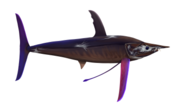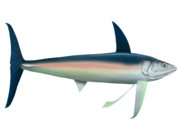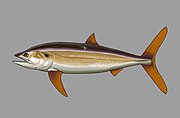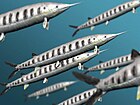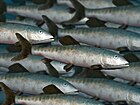
Actinopterygii, members of which are known as ray-finned fish or actinopterygians, is a class of bony fish that comprise over 50% of living vertebrate species. They are so called because of their lightly built fins made of webbings of skin supported by radially extended thin bony spines called lepidotrichia, as opposed to the bulkier, fleshy lobed fins of the sister class Sarcopterygii. Resembling folding fans, the actinopterygian fins can easily change shape and wetted area, providing superior thrust-to-weight ratios per movement compared to sarcopterygian and chondrichthyian fins. The fin rays attach directly to the proximal or basal skeletal elements, the radials, which represent the articulation between these fins and the internal skeleton.

The Amiiformes order of fish has only two extant species, the bowfins: Amia calva and Amia ocellicauda, the latter recognized as a separate species in 2022. These Amiiformes are found in the freshwater systems of North America, in the United States and parts of southern Canada. They live in freshwater streams, rivers, and swamps. The order first appeared in the Triassic, and the extinct members include both marine and freshwater species, many of which are morphologically disparate from bowfins, such as the caturids.
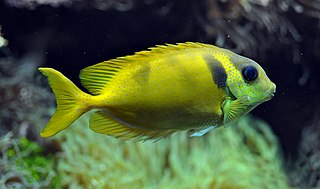
Neopterygii is a subclass of ray-finned fish (Actinopterygii). Neopterygii includes the Holostei and the Teleostei, of which the latter comprise the vast majority of extant fishes, and over half of all living vertebrate species. While living holosteans include only freshwater taxa, teleosts are diverse in both freshwater and marine environments. Many new species of teleosts are scientifically described each year.
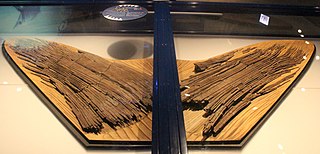
Leedsichthys is an extinct genus of pachycormid fish that lived in the oceans of the Middle to Late Jurassic. It is the largest ray-finned fish, and amongst the largest fish known to have ever existed.

Hypsocormus is an extinct genus of pachycormid fish from the Middle to Late Jurassic of Europe. Fossils have been found in Germany, France and the UK.
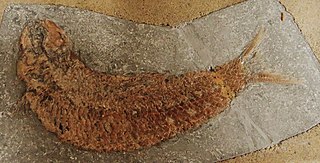
Pholidophorus is an extinct genus of stem-teleost fish. Numerous species were assigned to this genus in the past, but only the type species Pholidophorus latiusculus, from the Late Triassic of Europe, is considered to be a valid member of the genus today.
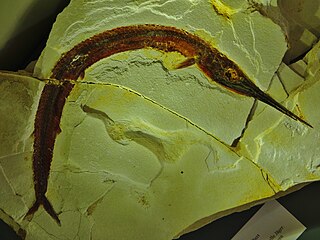
Aspidorhynchiformes is an extinct order of ray-finned fish. It contains only a single family, the Aspidorhynchidae. Members of the group are noted for their elongated, conical rostrums, of varying length, formed from fused premaxillae. The range of the group extends from the Middle Jurassic to the late Paleocene.
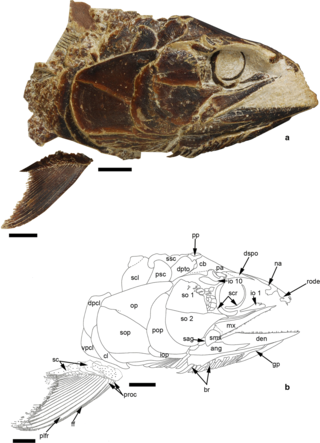
Pachycormus is an extinct genus of pachycormiform ray-finned fish known from the Early Jurassic of Europe. The type species P. macropterus was first named as a species of Elops by Henri Marie Ducrotay de Blainville in 1818, it was placed into the newly named genus Pachycormus by Louis Agassiz in 1833. Fossils have been found in marine deposits from France, Germany and England. Pachycormus has recently been considered monotypic, only containing P.macropterus, with other species considered junior synonyms of the former, though this has subsequently been questioned. Pachycormus has generally been considered basal among Pachycormiformes, with a recent phylogeny finding it to be the second most basal pachycormiform after Euthynotus. It grew up to 1 m (3.5 ft) in length. The teeth are short and designed for grasping. Its ecology has been interpreted as that of a generalist predator.

Euthynotus is an extinct genus of prehistoric bony fish that lived during the early Toarcian stage of the Early Jurassic epoch. It is generally considered the basalmost pachycormiform.
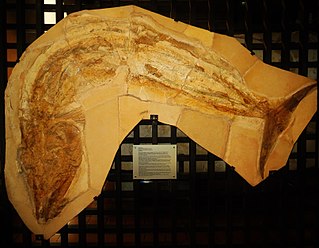
Asthenocormus is an extinct genus of pachycormiform ray-finned fish. A member of the edentulous suspension feeding clade within the Pachycormiformes, fossils have been found in the Upper Jurassic plattenkalks of Bavaria, Germany.

Prohalecites is an extinct genus of ray-finned fish from the Ladinian and possibly Carnian (Triassic) of Italy. It is the oldest known teleosteomorph, a group that includes extant teleosts and their close fossil relatives.

Orthocormus is an extinct genus of prehistoric pachycormiform bony fish. It is known from three species found in Late Jurassic (Kimmeridgian) aged plattenkalk deposits in Bavaria, Germany. The species "Hypsocormus" tenuirostris Woodward 1889 from the late Middle Jurassic (Callovian) Oxford Clay is not closely related to the type species of Hypsocormus, and is more closely related to Orthocormus + Protosphyraena, and thus has sometimes been referred to in open nomenclature as Orthocormus? tenuirostris. The species of Orthocormus reached over a metre in length, and are thought to have been pelagic predators.

Bonnerichthys is a genus of fossil fishes within the family Pachycormidae that lived during the Coniacian to Maastrichtian stage of the Late Cretaceous. Fossil remains of this taxon were first described from the Smoky Hill Member of the Niobrara Chalk Formation of Kansas, and additional material was later reported from the Pierre Shale, Mooreville Chalk, Demopolis Chalk, Wenonah Formation, and Moreno Formation, among other localities. It grew to at least 5 metres (16 ft) in total body length, substantially less than the related Leedsichthys from the Jurassic which likely grew up to 16.5 metres (54 ft).
Rhinconichthys is an extinct genus of bony fish which existed during the Cenomanian stage of the Late Cretaceous.
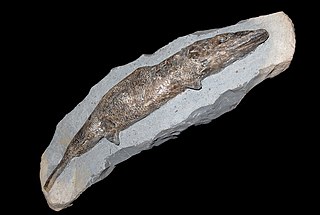
Crossognathiformes is an extinct order of ray-finned fish that lived from the Late Jurassic to the Eocene. Its phylogenetic placement is disputed; some authors have recovered it as part of the teleost stem group, while others place it in a basal position within crown group Teleostei.
This list of fossil fishes described in 2019 is a list of new taxa of jawless vertebrates, placoderms, acanthodians, fossil cartilaginous fishes, bony fishes, and other fishes of every kind that were described during the year 2019, as well as other significant discoveries and events related to paleoichthyology that occurred in 2019.

Teleosteomorpha is a clade of ray-finned fishes containing all teleost fish and their closest extinct relatives. Also in this group are the Aspidorhynchei, which is composed of two dominant Mesozoic fish orders, the Aspidorhynchiformes and the Pachycormiformes. Several other non-teleostomorph teleosteans existed throughout the Mesozoic, although not as dominant as the two main clades in the group.
Australopachycormus is an extinct genus pachycormiform fish. It is only known from the type species, A. hurleyi, from the Early Cretaceous (Albian) Toolebuc Formation of Queensland, Australia. Like the related Protosphyraena, it possessed an elongated rostrum.
Martillichthys is an extinct genus of pachycormiform fish, known from the late Middle Jurassic (Callovian) Oxford Clay, England. It is a member of the suspension feeding clade within the Pachycormiformes, most closely related to Asthenocormus.
This list of fossil fish research presented in 2022 is a list of new taxa of jawless vertebrates, placoderms, acanthodians, fossil cartilaginous fishes, bony fishes, and other fishes that were described during the year, as well as other significant discoveries and events related to paleoichthyology that occurred in 2022.



